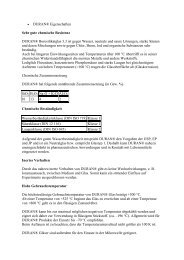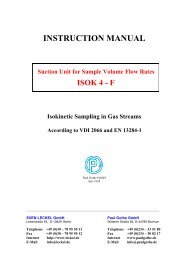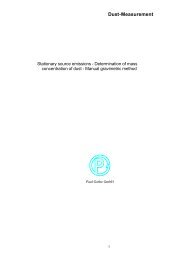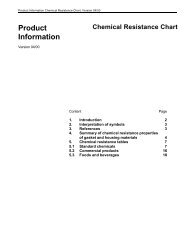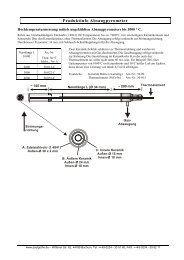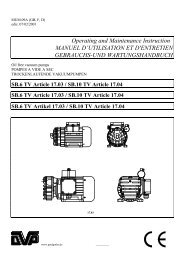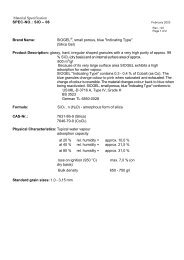Chemical resistance of NIROSTA steels - Rovasta
Chemical resistance of NIROSTA steels - Rovasta
Chemical resistance of NIROSTA steels - Rovasta
Create successful ePaper yourself
Turn your PDF publications into a flip-book with our unique Google optimized e-Paper software.
<strong>Chemical</strong> <strong>resistance</strong> <strong>of</strong> <strong>NIROSTA</strong> ® <strong>steels</strong><br />
34<br />
Corrosive agent Formula Condition Concentration<br />
Sulphuric acid 1 ) H 2 SO 4 98 % (concentrated)<br />
Sulphuric acid 1 ) H 2 SO 4 98 % (concentrated)<br />
Sulphuric acid 1 ) H 2 SO 4 98 % (concentrated)<br />
Sulphuric acid 1 ) H 2 SO 4 98 % (concentrated)<br />
Sulphuric acid 1 ) fuming (11 % free SO 3 )<br />
Sulphuric acid 1 ) fuming (11 % free SO 3 )<br />
Sulphuric acid 1 ) fuming (60 % free SO 3 )<br />
Sulphuric acid 1 ) fuming (60 % free SO 3 )<br />
Sulphurous acid H 2 SO 3 saturated<br />
Sulphurous acid H 2 SO 3 4 bar<br />
Sulphurous acid H 2 SO 3 5–8 bar<br />
Sulphurous acid H 2 SO 3 10–20 bar<br />
Sulphurous acid, gas (SO 2 ) moist, free <strong>of</strong> SO 3<br />
Sulphurous acid, gas (SO 2 ) moist, free <strong>of</strong> SO 3<br />
Sulphurous acid, gas (SO 2 ) moist, free <strong>of</strong> SO 3<br />
Sulphurous acid, gas (SO 2 ) moist, free <strong>of</strong> SO 3<br />
Super phosphate Ca(H 2 PO 4 ) 2 + CaSO 4 + 3 % H 2 SO 4<br />
Tannic acid (tannin) 5%<br />
Tannic acid (tannin) 5%<br />
Tannic acid (tannin) 10 %<br />
Tannic acid (tannin) 10 %<br />
Tannic acid (tannin) 50 %<br />
Tannic acid (tannin) 50 %<br />
Tannin<br />
see tannic acid<br />
Tar, pure<br />
Tartar<br />
see potassium bitartrate<br />
Tartaric acid COOH(CHOH) 2 COOH 10 %<br />
Tartaric acid COOH(CHOH) 2 COOH 10 %<br />
Tartaric acid COOH(CHOH) 2 COOH 50 %<br />
Tartaric acid COOH(CHOH) 2 COOH 50 %<br />
Thioglycolic acid<br />
HSCH 2 COOH<br />
Thioglycolic acid<br />
HSCH 2 COOH<br />
Tin Sn molten<br />
Tin Sn molten<br />
Tin Sn molten<br />
Tincture <strong>of</strong> iodine<br />
Toluene C 6 H 5 CH 3<br />
Trichloroacetic acid CCI 3 COOH 80 %<br />
Trichloroethylene 2 ) C 2 HCI 3 anhydrous<br />
Trisodium phosphate<br />
see sodium phosphate tert.<br />
Turpentine<br />
1<br />
) Oxidising conditions can considerably expand the applications <strong>of</strong> stainless <strong>steels</strong>.<br />
Please enquire with the manufacturers.<br />
2<br />
) Even if only traces <strong>of</strong> hydrochloric acid (HCI) are formed by moisture, there is a danger <strong>of</strong> pitting, crevice and stress corrosion cracking.



